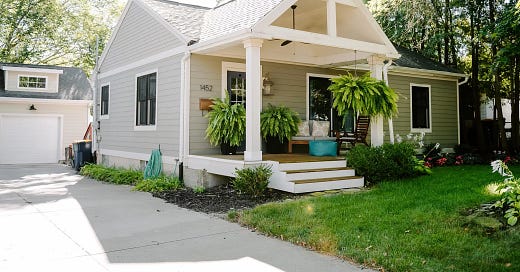If you've tried to buy or rent a home recently, you've felt the pain of America's housing crisis. Before we can solve this challenge affecting millions of families, we need a shared understanding of what's happening and why.
There are excellent books that thoroughly explain these issues (linked at the bottom), but most people don't have time to read them all. Here's what you need to know in just a few minutes:
The Housing Crisis in 60 Seconds
Housing prices are sky-high because of artificial scarcity. When more people want homes than there are homes available, prices surge. In many places, median home prices have increased over 150% in the past decade, while wages grew only about 50%.
Many powerful stakeholders benefit from the status quo. People who already own homes often see housing scarcity as positive because it makes their property more valuable. A typical homeowner in West Michigan saw their home value increase by over $100,000 in just the four years from 2019 - 2023.
Even housing advocates disagree on solutions. While building more homes is the obvious answer, there's significant conflict about what types of homes to build, where to build them, and who should get to live in them.
That's the simple version of a complex story. For those interested in digging deeper, let's explore each of these points.
Why Housing Has Become Unaffordable: Scarcity Explained
What does housing scarcity really mean? Simply put, we haven't built enough homes across most of the country to keep pace with population growth and household formation. Meanwhile, some existing housing has deteriorated beyond repair.
Think about basic economics: when many people want something that's in limited supply, prices rise dramatically. I’m old enough to remember when Beanie Babies selling for $5 at CVS suddenly commanded $250 from collectors? Or how concert tickets for popular artists can resell for 10 times their face value?
Housing works the same way. When more families want to live in a neighborhood than there are available homes, prices climb faster than wages can keep up. During the pandemic, we saw extreme examples with homes selling $100,000 above asking price through bidding wars with all-cash offers, often $20,000 to $50,000 over asking price.
The solution seems obvious: build more homes to meet demand. When supply matches or slightly exceeds demand, prices stabilize and may eventually decrease (see housing prices in Austin, TX from 2022 - 2025).
So why don't we just build more housing? That brings us to the second point.
Who Benefits From the Housing Crisis?
For existing homeowners, housing scarcity creates a financial windfall. Their homes—which they can live in while also building wealth—appreciate faster than inflation.
In American culture, homeownership has become the primary retirement strategy for many families. Buy a house, make payments for 30 years, and end up with an asset worth several times more than what you paid. This wealth-building mechanism depends entirely on continued scarcity.
If we created a system where everyone who wanted a home could afford one, the average home value would likely stop rising dramatically and might even decline as buildings naturally age and depreciate—just like cars, furniture, and most other physical assets.
This creates a powerful incentive for homeowners to resist new housing development, especially in their neighborhoods. They may intellectually understand the housing crisis while emotionally and financially benefiting from it.
The Challenge of Finding Common Ground
A growing coalition of organizations, businesses, and community members recognizes the housing shortage and advocates for more homes. However, this diverse group often disagrees on implementation.
Different Visions, Different Priorities
Affordability advocates want housing for the lowest-income households. This noble goal requires significant subsidies to cover the gap between construction costs and what people can afford. In most places, local government and philanthropy simply can't provide enough funding to meet this need.
Neighborhood preservationists only support building single-family homes on large lots that match existing neighborhoods. Whether motivated by nostalgia or resistance to change, this approach is land-intensive and expensive, serving only a limited segment of the market.
Silent supporters understand the need for diverse housing types at various price points but hesitate to advocate for change. They anticipate fierce opposition from both groups above and decide the political battle isn't worth fighting.
THIS IS THE WORK: Moving Forward Together
The path forward requires acknowledging uncomfortable truths:
Housing shortages directly cause unaffordability. Building more homes of all types is essential.
Our current system isn't designed for universal homeownership. We need to either change the system or create alternative paths to housing security. Homeownership is an important goal for many households, but it cannot be the only option we advocate for.
Communities need diverse housing options. Our households come in different sizes, with varying incomes and needs. While single-family homes worked well for many between 1950-2010, we need more options now.
By working together to increase housing supply and provide more diverse options, we can create communities where everyone has access to safe, stable housing they can afford.
For those wanting to learn more, I highly recommend "Escaping the Housing Trap" by Chuck Marohn and Daniel Herriges, which provides a comprehensive analysis of how we got here and how we can move forward.
Other important titles include:
Fixer Upper: by Jenny Scheutz
The Affordable City: by Shane Phillips, see also The Terner Center for Housing Innovation
Backdoor Revolution: by Kol Peterson
Antifragile: by Nassim Taleb
Abundance: by Ezra Klein & Derek Thompson







Well said. thank you
Thank you, John.